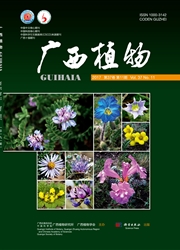

 中文摘要:
中文摘要:
横断山区作为青藏高原东南部主要的一个冰期避难所,第四纪冰期气候的变化对该地区的植物地理分布和居群遗传结构都产生了重要的影响。为了揭示该地区物种分布的分子系统地理学结构,选取在该地区广泛分布的一种高山灌木-高山绣线菊的叶绿体trnL-trnF序列进行研究。采集了15个居群182个个体进行测序,共发现7个单倍型。总的遗传多样性较高(HT=0.809),但居群内遗传多样性较低(HS=0.236)。分子变异分析(AMOVA)结果表明分布区内高山绣线菊的遗传变异主要存在于居群间(84.48%),且居群间的遗传分化很高(GST=0.708,FST=0.84476,NST=0.863),有着显著的谱系地理学结构(NST〉GST,P〈0.01)和较低的居群间平均基因流(Nm=0.09)。单倍型的系统进化树和进化分支网络分析得到了相似的拓扑结构,7种单倍型都按照地理分布聚为三支:横断山区西部、横断山区东部以及两者的交接地带。本研究推测该物种在横断山区存在多个冰期避难所,而没有表现出大规模的种群集体扩张和迁移的现象。青藏高原隆升、第四纪气候的反复波动以及横断山区特殊的地理环境使得原来连续的居群片段化,并发生范围扩张,从而塑造了高山绣线菊的现代生物地理分布格局。
 英文摘要:
英文摘要:
The Hengduan Mountains and adjacent regions have been suggested as the important refugia located in the southeast of Qinghai-Tibet Plateau.Climate change in the Quaternary Glacial Period has an important effect on spatial distribution and genetic structure of plant distributed there.In this study , the chloroplast trnL-trnF sequence variation of a perennial shrubby species were examined.Sequence data were obtained from 182individuals of 15groups covering the Hengduan Mountains.And 7haplotypes were detected.The total diversity ( H T =0.809 ) was high while the within-population diversity ( H S =0.236 ) was low.Molecular variation analysis ( AMOVA ) results revealed a high level of genetic differentiation ( 84.48% ) among populations.The estimates of interpopulation differentiation were very high ( G ST =0.708 , F ST =0.84476 , N ST =0.863 ) .Further , the higher N ST than G ST suggested a distinctly phylogeographical pattern whereas the value of average gene flow ( N m =0.09 ) was low.Phylogenetic relationship ofthe 7haplotypes detected had similar topology with Maximum likelihood ( ML ) tree analyses.Phylogenetic analyses of haplotypes indentified 3major clusters of the recovered haplotypes : east , west and the third one in between the first two.Our results indicated that there were multiple refugia for this species during the glacical stages.We failed to detect the large-scale interglacial or postglacial range expansion in this species.The special phylogeographic structure of S.alpina may have resulted from a combination of the uplift of the Qinghai-Tibet Plateau , Quaternary climatic oscillation and complex topology of the Hengduan Mountains.
 同期刊论文项目
同期刊论文项目
 同项目期刊论文
同项目期刊论文
 Phylogeography of Spiraea alpina (Rosaceae) in the Qinghai-Tibetan Plateau inferred from chloroplast
Phylogeography of Spiraea alpina (Rosaceae) in the Qinghai-Tibetan Plateau inferred from chloroplast 期刊信息
期刊信息
